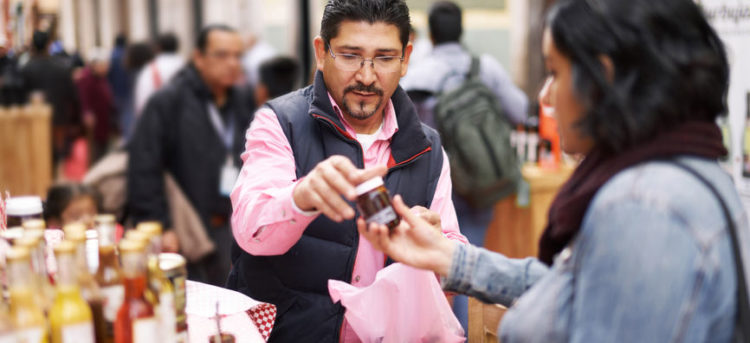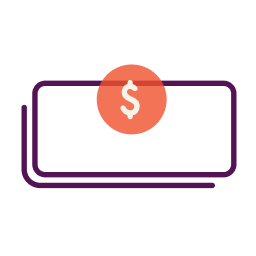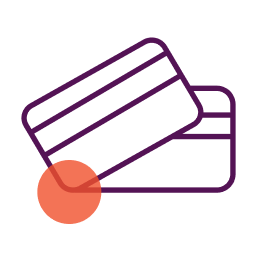A farmers market is a great place to show off and sell your produce, baked goods, and other local items. As of 2014, there were more than 8,200 farmers markets around the country, reaching over $1 billion in sales. If you want your slice of that big pie, you may want to add your local farmers market to your sales strategy.
Success at a farmers market takes more than just showing up, however. You need to position your brand and your booth at the market to show off the best of what you have to offer. Read on to learn more about how to maximize your sales at farmers markets.
1. Don’t ignore signage.
At farmers markets around the country, it is common to use a banner for signage. That is a good choice, but don’t just put the name of your business on a boring banner. Make it something fun and attractive to someone walking by. Also, make it very clear on the sign what you offer in case someone’s view of your tables is blocked by browsers when passing by.
A good sign should include your business name and logo. You may also want to include a phone number, address, website, or social media usernames to help people connect and buy from you later just in case they are not ready to buy on the spot.
2. Find the pricing sweet spot.
If you walk around a farmers market looking for cabbage, you will probably find multiple sellers offering different varieties and different prices. Farmers market shoppers may be price sensitive, so scout out your competition to make sure your pricing is in-line with the average at your farmers market.
Charging too much will lead shoppers to spend their money elsewhere. Charging too little squeezes your margins and hurts your profits. To maximize the bottom line, test pricing strategies until you find the perfect one for your local market.
3. Display your best products front and center.
If you have one product that makes up the majority of your sales or is just prettier and more exciting than the rest, put it on display front and center. Unlike a grocery store that puts milk and eggs at the back of the store to make shoppers walk, you can’t count on that at a farmers market.
Make it abundantly clear what you want people to see. Consider adding additional signage, displays, or other enhancements to make it pop.
4. Eliminate analysis paralysis.
In business, there is a term “analysis paralysis.” The concept states that if consumers have too many choices, they may not make one at all. For example, if you sell jam, should you put out 20 flavors or just three? One might think that putting out 20 will lead to more sales, but that may not be the case.
In a well-known case study, a marketer tried just that. In the Columbia University study, researcher Sheena Inyengar set up a table filled with high end jams and offered samples. But for some customers, Inyengar offered 24 jams with others only had six to choose from.
Interestingly, of the customers who were offered 24 flavors, only three percent made a purchase. Of the customers offered six flavors, thirty percent made a purchase. A reduction in choice by 75 percent led to 10x boost in sales. Keep that in mind when formulating a merchandising plan.
5. Plan for cards in addition to cash.
While cash is most popular at fast-food restaurants and coffee shops, according to a TSYS survey, the most popular way to pay at most places these days is with a card. Credit or debit? It doesn’t matter, you should accept both at your booth!
Accepting credit card payments on the go used to be a nightmare, but now it is simple. With popular mobile payment processors like Square and PayPal, there is no excuse to say “cash only” in 2018 and beyond.
I know that I have walked away from stores and restaurants over a cash only policy, and I’m not alone. Millennials are the biggest population segment and prefer to pay with plastic for its convenience. And mobile payments are just taking off, so get ready to accept those as well.
6. Samples work… but don’t go overboard.
If you want to lure in a passerby, one easy way to do so is with free food. Just like clubs in high school and college, free food always perks up people’s attention. Offering samples can be a great way to generate sales if the sample lives up to a high standard.
At a recent visit to a California farmers market, I sampled a type of orange I had never tried before. After one bite of that Cara Cara orange, I was hooked. I bought a half dozen and went back the next two weeks in a row to buy them again.
But we all know that not all grazers will become customers, so don’t make your samples too big. You want them to buy, not get the whole experience from the sample.
7. Farmers markets are a great way to grow your business.
A farmers market won’t get you national exposure, but it will help you build brand loyalty in your local area. Building a strong fan base will help your business grow to the next level. It might all start at your local farmers market.
This article was originally written on May 14, 2018.



Have at it! We'd love to hear from you and encourage a lively discussion among our users. Please help us keep our site clean and protect yourself. Refrain from posting overtly promotional content, and avoid disclosing personal information such as bank account or phone numbers.
Reviews Disclosure: The responses below are not provided or commissioned by the credit card, financing and service companies that appear on this site. Responses have not been reviewed, approved or otherwise endorsed by the credit card, financing and service companies and it is not their responsibility to ensure all posts and/or questions are answered.